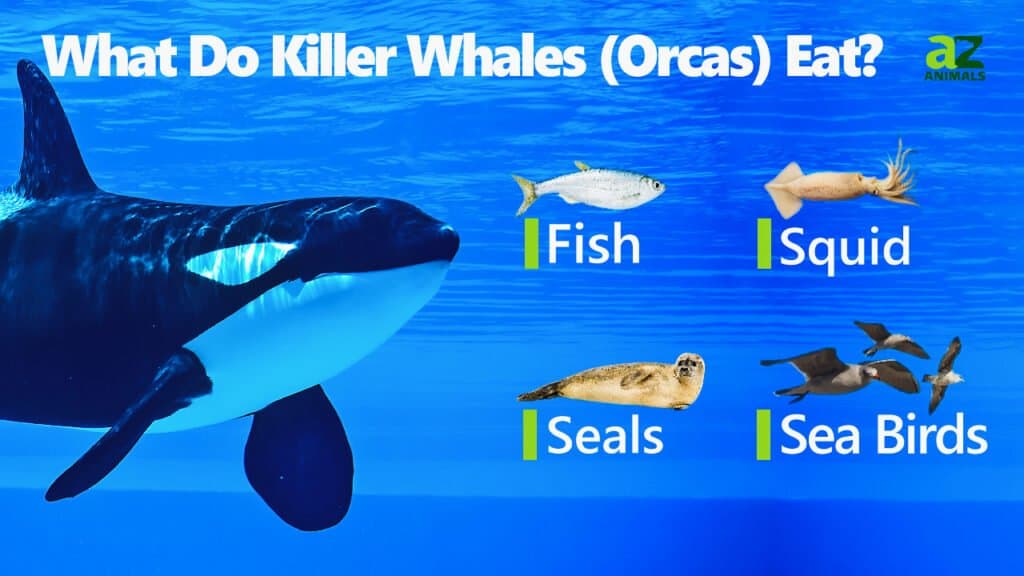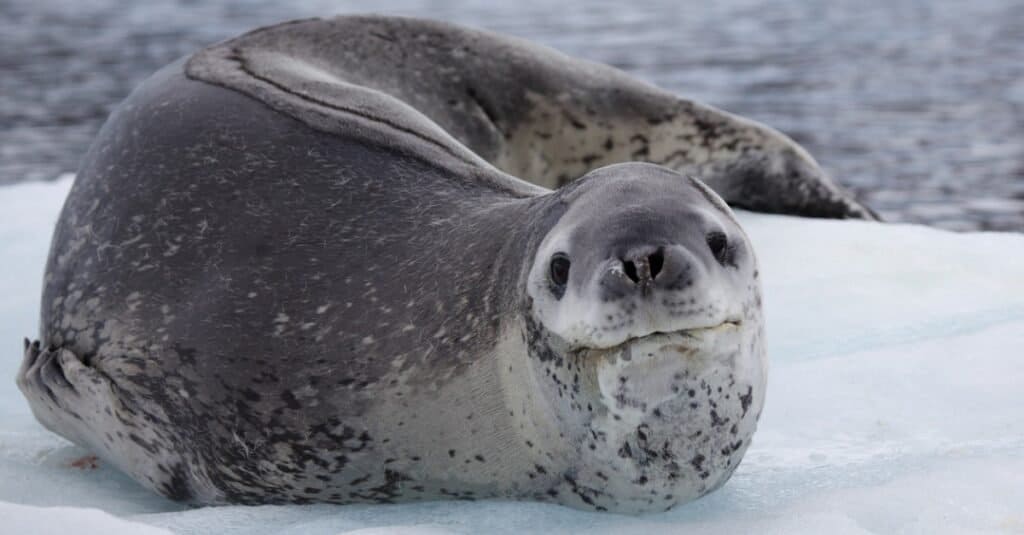Leopard seals and orcas are considered apex predators in their habitats. They are the largest species of their kind. However, many differences can help you tell them apart, starting with their size and appearance, and ending with their interaction with humans.
Let’s find out what makes these animals unique and how we can distinguish them!
Comparing Leopard Seal vs Orca
| Leopard Seal | Orca | |
|---|---|---|
| Size | Length: 7.9–11.5 feet (95–138 kg) Weight: 440–1,300 pounds (200 kg–590 kg) | Length: 20 – 26 feet (males); 16 – 23 feet (females); 7.9 feet (calves) Weight: 12,000 pounds (6 short tons) for males; 6,600 – 8,800 pounds (3.3 – 4.4 short tons) for females; 400 pounds (calves) |
| Appearance | – Rounded head, big snout, large mouths, flippers on all four feet – Dark gray or black head and back; – White or light gray around the belly | – Black-and-white body; – White underside and black upper side; – Different black-and-white color patterns in males, females, and calves |
| Classification | Kingdom: Animalia Phylum: Chordata Class: Mammalia Order: Carnivora Family: Phocidae Genus: Hydrurga Species: Hydrurga leptonyx | Kingdom: Animalia Phylum: Chordata Class: Mammalia Order: Artiodactyla Family: Delphinidae Genus: Orcinus Species: Orcinus orca |
| Distribution and Habitat | – Primarily inhabiting the Antarctic pack ice; – Spotted in Australia, New Zealand, South America, South Africa | – They prefer higher latitudes and coastal waters; – Many orcas live in the northeast Atlantic in the Gulf of Alaska, the Norwegian coast, and others |
| Predators and Threats | Sharks, killer whales (orcas), climate change | No natural animal predators; water pollution, human action, diseases |
| Behavior | Solitary, vocal | Social creatures; like traveling and foraging |
| Lifespan | 20-24 years | 30 – 50 years in the wild; 10 – 45 years in captivity |
| Conservation Status | Least Concern | Data Deficient |
The Key Differences Between Leopard Seals and Orcas
While leopard seals and orcas have some things in common, their differences prevail, starting with the fact that they belong to different orders and families. Their size and appearance are the most important things that can help distinguish them. Other dissimilarities are highlighted by their diets, habitats, predators, and interactions with humans. Keep reading as we discuss these differences in detail!
Leopard Seal vs Orca: Size

Leopard seals have an average length of 7.9 – 11.5 feet.
©iStock.com/Bkamprath
One of the most significant and notable differences between leopard seals and orcas is the size. Orcas are considerably larger than leopard seals. Let’s see how large these two animals can get and how much they can weigh.
Leopard seals have an average length of 7.9 – 11.5 feet. They weigh approximately 440 – 1,300 pounds. By comparison, the smallest adult orcas weigh approximately five times as much. Male orcas weigh about 12,000 pounds. Female orcas are smaller, and their weight ranges from 6,600 to 8,800 pounds. Their calves weigh approximately 400 pounds when they are born.
In terms of length, the difference is more notable for males than it is for females, as some female orcas can measure 16 feet, which is not far from the 11.5-foot leopard seal’s average length. But that’s only if we compare leopard seals to the smallest female orcas or their newborn calves, which measure 7.9 feet long. If we compare the largest leopard seal (up to 13 feet long) to the largest female orca in the world (28 feet long), the difference is outstanding!
The result is the same if we compare the length of leopard seals with that of male orcas. Male orcas have an average length of up to 26 feet! The largest male orca measured 32 feet long and weighed 22,000 pounds, which are huge numbers compared to those of leopard seals!
Another difference is that leopard seal females are larger than leopard seal males, while orca males are larger than orca females.
Leopard Seal vs Orca: Appearance

Orcas have a black-and-white color pattern.
©slowmotiongli/Shutterstock.com
Leopard seals have long and muscular bodies. They feature color patterns with shades ranging from silver to dark gray. Moreover, leopard seals’ bodies have notable spots, just like those of a leopard (hence their names). These animals have a rounded head, a big snout, and a large mouth that hosts 32 teeth.
Orcas have different pigmentation. They have a black-and-white color pattern. Their undersides are white, and the upper sides are black. While this unique coloration helps us distinguish them from leopard seals, it is similar to those of false orcas (a species of oceanic dolphins) or Risso’s dolphins. Some orcas can have gray, brown, and yellow patterns. There are also albino and melanistic orcas. These animals have large, rounded pectoral fins, which are much bigger in males. Male dorsal fins are twice the size of female dorsal fins, reaching up to 5.9 feet high. Males also have longer jaws. Orcas can have 40 to 56 strong, interlocking teeth.
Leopard Seal vs Orca: Distribution and Habitat
As opposed to orcas, which can be found worldwide, leopard seals primarily inhabit the Antarctic ice pack. Even though they’ve been spotted in Australia, New Zealand, South America, and South Africa, they rarely venture outside their natural habitat.
On the other hand, orcas live in worldwide waters, including those around Iceland, Norway, New Zealand, California, and the Gulf of Alaska. These animals prefer higher latitudes and coastal waters.
Leopard Seal vs Orca: Diet

While both animals are carnivores, their diets have adapted to their habitats. The krill is the primary food source for leopard seals, but they also feed on squid, fish, penguins, and shellfish.
Orcas are apex predators and feed on sea turtles, seabirds, cephalopods, mammals, and fish.
Leopard Seal vs Orca: Predators and threats
While both animals are considered apex predators, leopard seals are only “half-apex predators,” if we can call them this way. While some do consider leopard seals Antarctica’s apex predators, they still have a natural predator, the orca. Since orcas breed in Antarctic waters and the Antarctic orca population consists of approximately 70,000 individuals, leopard seals often fall prey to orcas.
Leopard Seal vs Orca: Interaction with Humans

Leopard seals are solitary and often aggressive to one another, particularly around food.
©Mogens Trolle/Shutterstock.com
Leopard Seals
Leopard seals are solitary animals that live in the Antarctic ice pack. As such, there isn’t much to say about their interactions with humans. They rarely attack humans and aren’t affected by human action too much, except for the long-term climate change and occasional deaths caused by entanglements in fishing nets. There have been only several leopard seal attack records; the last one occurred in 2021. The only fatal leopard seal attack happened in 2003 when a leopard seal attacked and killed Kirsty Brown while she was snorkeling in Antarctica.
Orcas
Orca-human interaction is a whole different story. The first written description of orcas dates from approximately AD 70. These animals were depicted as dangerous creatures (hence their alternative name of “killer whales”). Their broad cultural influence started with the indigenous people of the Pacific Northwest Coast, however, who didn’t see orcas as their enemies. These tribes considered orcas the most powerful oceanic animals and assumed they lived in underwater towns and that they could take human form when they came to the surface. It was also believed that they invited drowned people to live in their towns. Some tribes saw orcas as benefactors of humans.
People started hunting whales during the 18th century. However, the International Whaling Commission recommended a ban on commercial orca hunting. Nowadays, except for Indonesia and Greenland, orcas aren’t hunted for commercial purposes.
During the past few years, whale watching has become one of the most significant human-orca interactions. As relaxing and beautiful as this recreational activity may sound, the vessels coming to orcas’ habitat harm it, causing a population decline.
Orcas are often kept in captivity at aquatic theme parks or aquaria, where they can develop various severe health conditions. Unfortunately, orca theatrical shows are still ongoing.
There have been only a few confirmed wild orca attacks, but none were fatal. On the other hand, captive orcas attacked more people, and some of the attacks were fatal, which indicates that living in captivity affects their behavior.
Up Next:
- Leopard Seal vs Sea Lion: The Key Differences
- Orca vs Blue Whale: Who Would Win in a Fight?
- Orca vs Great White: Who Is The Superior Predator?
The photo featured at the top of this post is ©
Thank you for reading! Have some feedback for us? Contact the AZ Animals editorial team.







